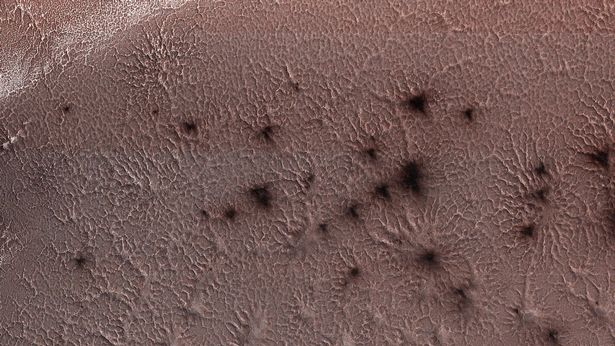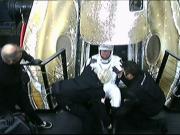Space enthusiasts were spooked out when pictures of Mars' surface showing what looked like creepy black 'giant spiders' were released around 20 years ago.
The pictures ignited wild conspiracy theories throughout the years claiming the red planet is filled with worms underneath its soil and also baffled scientists all these years.

However, the mystery has finally been unraveled after a team of scientists recreated a smaller version similar to the 'giant spiders' seen on Mars in their lab and reported in their study that the patterns are formed by gas, which is referred to as sublimation, reports Space.com.
Scientists created a slab of carbon dioxide ice, commonly known as dry ice, and used a simulator to release the atmosphere found on Mars, in the lab.
When the cold ice slab made contact with the warmer bed of Mars-like sediment, parts of the ice transformed from solid state to gas and the process formed 'spidery cracks' as escaping gas was pushed through the ice, claimed the report published in the journal of Scientific Reports.

The research also claimed that the 'spiders' on Mars usually gets formed in the spring, when sunlight penetrates the layer of CO2 ice and warms the surface underneath.
The heat causes pressure to build up under the ice sheet until it finally cracks leaving spider-like layouts, as the gas escapes through the cracks making a zig-zag pattern.
"This research presents the first set of empirical evidence for a surface process that is thought to modify the polar landscape on Mars ," lead study author Lauren McKeown said in the Journal, while another Planetary Scientist from the Open University in England added, "The experiments show directly that the spider patterns we observe on Mars from orbit can be carved by the direct conversion of dry ice from solid to gas."
More than 95% of the Martian atmosphere contains carbon dioxide (CO2), states NASA, revealing that the ice and frost that form around the south and north poles in winter are also made of CO2.
Up until now, researchers could not test the spider like cracks on Earth due to different atmospheric conditions but researchers finally managed to make a little piece of Mars by using a simulation chamber lab and placing sediment grains of varying size inside that replicates the red planet.








